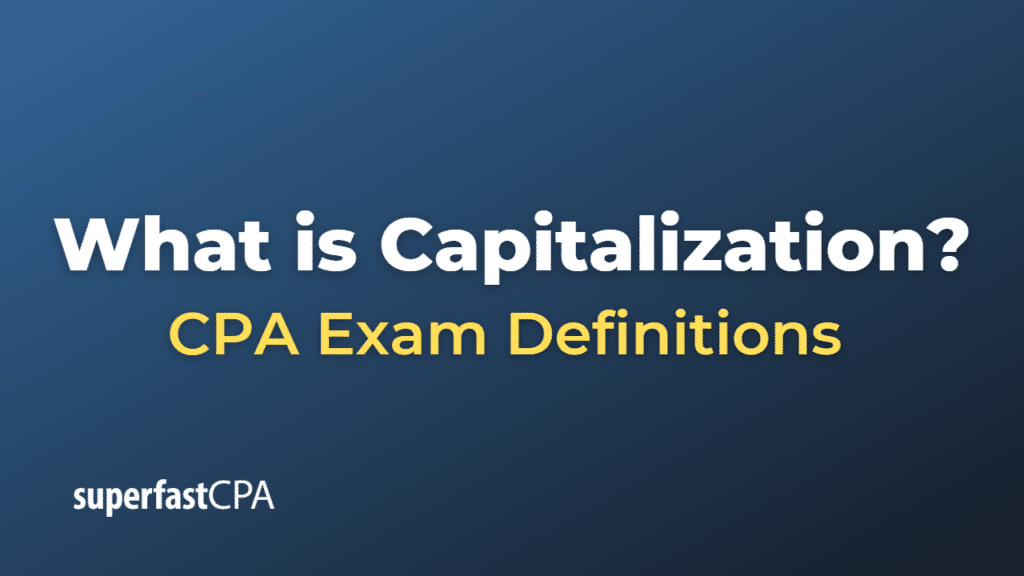Capitalization
Capitalization, in finance and accounting, has multiple meanings, depending on the context in which it is used. Here are the most common meanings:
- Market Capitalization: In the context of stock markets, capitalization refers to the total market value of a publicly traded company’s outstanding shares of stock. It is calculated by multiplying the current market price of a single share by the total number of outstanding shares. Market capitalization is an indicator of a company’s size, financial stability, and growth potential.
- Capitalizing Assets: In accounting, capitalization refers to the process of recording the cost of an asset as a fixed asset on the balance sheet, rather than expensing the cost immediately. This process involves allocating the cost of the asset over its useful life using depreciation (for tangible assets) or amortization (for intangible assets). Capitalizing assets allows companies to match the cost of an asset with the revenues it generates over time, providing a more accurate representation of the company’s financial performance.
- Capitalization of Earnings: In the context of business valuation, capitalization refers to the process of converting a company’s future earnings or cash flows into a present value. This is done by applying a capitalization rate or discount rate, which reflects the risk and expected return associated with the investment. Capitalization of earnings is a common method used to estimate the value of a business or income-generating property.
- Capitalization of Interest: In the context of long-term construction projects or self-constructed assets, capitalization refers to the process of adding the interest expense incurred during the construction period to the cost of the asset. This practice is in accordance with the Generally Accepted Accounting Principles (GAAP) and the International Financial Reporting Standards (IFRS). By capitalizing interest, companies can recognize the full cost of constructing an asset, including the financing costs.
These various meanings of capitalization all relate to the process of assigning value or cost to different financial elements, whether it’s the value of a company’s stock, the cost of an asset, or the present value of future earnings.
Example of Capitalization
I’ll provide an example for each of the meanings of capitalization mentioned earlier:
- Market Capitalization:
Let’s say Company A has 10 million outstanding shares of stock, and the current market price per share is $20. The market capitalization of Company A would be:
Market Capitalization = Number of Shares x Share Price = 10,000,000 shares x $20 = $200,000,000
Company A has a market capitalization of $200 million, which reflects its size and perceived value in the stock market.
- Capitalizing Assets:
Suppose a company purchases a piece of machinery for $100,000 with an expected useful life of 10 years and no salvage value. Instead of expensing the entire cost of $100,000 in the year of purchase, the company will capitalize the asset by recording it as a fixed asset on the balance sheet and depreciating it over its 10-year useful life. In this case, the annual depreciation expense would be:
Capitalizing Assets: Suppose a company purchases a piece of machinery for $100,000 with an expected useful life of 10 years and no salvage value. Instead of expensing the entire cost of $100,000 in the year of purchase, the company will capitalize the asset by recording it as a fixed asset on the balance sheet and depreciating it over its 10-year useful life. In this case, the annual depreciation expense would be:
Depreciation Expense = (Cost – Salvage Value) / Useful Life = ($100,000 – $0) / 10 = $10,000
Each year, the company will record a depreciation expense of $10,000, spreading the cost of the machinery over its useful life.
- Capitalization of Earnings:
Imagine an investor wants to estimate the value of a small business that generates a stable annual net income of $50,000. The investor believes an appropriate capitalization rate for this type of business is 10%. The capitalized value of the business would be:
Capitalization of Earnings: Imagine an investor wants to estimate the value of a small business that generates a stable annual net income of $50,000. The investor believes an appropriate capitalization rate for this type of business is 10%. The capitalized value of the business would be:
Capitalized Value = Annual Net Income / Capitalization Rate = $50,000 / 0.1 = $500,000
Using the capitalization of earnings method, the estimated value of the business is $500,000.
- Capitalization of Interest:
A company is constructing a building that takes two years to complete, with a total construction cost of $5,000,000. The company has taken a loan to finance the construction, and the interest expense during the construction period is $200,000. Instead of expensing the interest immediately, the company capitalizes it by adding it to the cost of the building:
Capitalization of Interest: A company is constructing a building that takes two years to complete, with a total construction cost of $5,000,000. The company has taken a loan to finance the construction, and the interest expense during the construction period is $200,000. Instead of expensing the interest immediately, the company capitalizes it by adding it to the cost of the building:
Capitalized Building Cost = Construction Cost + Capitalized Interest = $5,000,000 + $200,000 = $5,200,000
The building will be recorded on the balance sheet with a capitalized cost of $5,200,000, reflecting both the construction cost and the interest expense incurred during the construction period.













